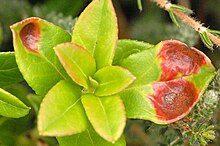Ustilaginomycotina
| Ustilaginomycotina | ||||||||||||
|---|---|---|---|---|---|---|---|---|---|---|---|---|

Corn blight ( Ustilago maydis ) |
||||||||||||
| Systematics | ||||||||||||
|
||||||||||||
| Scientific name | ||||||||||||
| Ustilaginomycotina | ||||||||||||
| R. Bauer , Begerow , JP Samp. , M. Weiß & Oberw. |
Ustilaginomycotina is a subdivision of the stand mushrooms (Basidiomycota) with around 1,500 species and includes the smut fungi in the broader sense. They are obligate parasites , mainly on plants; only the commensal genus Malassezia parasitizes animals optionally. The species get their name from the dark spores that make infected parts of plants look like they have been burned.
features
The diagnostic features for the subdivision are a 5S type B RNA and a cell wall characterized by the dominance of glucose and the absence of xylose .
The species are dimorphic: They have a haploid phase that grows like a yeast and lives saprobionic , as well as a dikaryotic phase that forms hyphae and lives parasitically . Not all representatives form teliospores , here burned spores. They are absent in Graphiola , Exobasidium , Microstroma and some smaller genera.
The septal pores are enclosed by membrane caps on both sides, a feature that distinguishes them from the other two groups of mushrooms . Deposits exist in the zones of interaction with the host due to exocytosis of primary interaction vesicles.
Life cycle
The characteristic life cycle of the Ustilaginomycotina species is as follows: The basidiospores germinate and form yeast-like stages that live saprobionic. When it comes into contact with a compatible cell, conjugation leads to the formation of a pair of nuclei (dikaryotic) cells that grow into a dikaryotic mycelium. This mycelium lives parasitically. Infection of the host plant is only possible with dikaryotic cells. The mycelium forms probasidia, the teliospores . These are usually thick-walled and detach from the mycelium. The teliospores are formed in the parenchyma by different organs of the host: in roots, stems, leaves, inflorescences, anthers and ovules. The teliospores have a powdery consistency and dark brown to black color, which is why they are also called incendiary spores. In the teliospores, nuclei are paired and subsequently meiosis, while germination creates a basidia with four basidiospores.
ecology
The vast majority of Ustilaginomycotina species parasitize flowering plants. Malassezia lives on the skin of warm-blooded animals including humans. Two species of Melaniella parasitize moss ferns , one species of Exoteliospora on ferns and two species of Uleiella on conifers. All others parasitize on flowering plants, including mainly on monocots : 57% of the species parasitize on sweet grasses , 12% on sour grasses . Species with teliospores parasitize herbaceous plants, those without teliospores (such as naked basidia-like (Exobasidiales) and the representatives of the Microstromatales ) wood plants.
Systematics
The species in Ustilaginomycotina form as a monophyletic group one of the three subdivisions of the mushroom (Basidiomycota). They mainly contain the typical smut fungi, the anther spirits ( Microbotryaceae , however, are not included.) They are currently (as of 2014) divided into four classes with several orders:
-
Class Ustilaginomycetes
- Order Urocystales
- Order smut fungus (Ustilaginales)
-
Class Exobasidiomycetes
- Order Doassansiales
- Order Entylomatales
- Order Nacktbasidien (Exobasidiales)
- Order Georgefischeriales
- Order microstromatales
- Order Tilletiales
-
Class Malasseziomycetes
- Order Malasseziales
-
Class Moniliellomycetes
- Order Moniliellales
The subdivision of Ustilaginomycotina into holobasidiate smut fungus (Ustilaginales) and phragmobasidiate Tilletiales goes back to Louis René and Charles Tulasne (1847).
literature
- Dominik Begerow, Matthias Stoll, Robert Bauer: A phylogenetic hypothesis of Ustilaginomycotina based on multiple gene analyzes and morphological data . In: Mycologia . tape 98 , no. 6 , 2006, p. 906-916 , doi : 10.3852 / mycologia.98.6.906 .
Individual evidence
- ^ A b Robert Bauer, Dominik Begerow, Franz Oberwinkler: Advances in the systematics of the smut fungi . In: Journal of Plant Diseases and Plant Protection . tape 105 , 1998, ISSN 0340-8159 , p. 224-238 ( online [PDF]).
- ^ Johanes Ottow: Microbiology of Soils: Biodiversity, Ecophysiology and Metagenomics . Springer, 2011, ISBN 978-3-642-00824-5 , pp. 203 ( online ).
- ^ Robert Bauer, Dominik Begerow, José Paulo Sampaio, Michael Weiß, Franz Oberwinkler: The simple-septate basidiomycetes: a synopsis . In: Mycological Progress . tape 5 , 2006, p. 41-66 , doi : 10.1007 / s11557-006-0502-0 .
- ↑ David S. Hibbett, Manfred Binder et al .: A higher-level phylogenetic classification of the Fungi . In: Mycological Research . tape 111 , no. 5 . British Mycological Society, 2007, p. 509-547 , doi : 10.1016 / j.mycres.2007.03.004 ( PDF; 804 KB ).
- ↑ D. Begerow, AM Schäfer, R. Kellner, A. Yurkov, M. Kemler, F. Oberwinkler, R. Bauer: Ustilaginomycotina. In: DJ McLaughlin, JW Spatafora (Eds.): The Mycota. vol. 7. Part A: Systematics and evolution. 2nd Edition. Springer, Berlin 2014.
- ↑ QM Wang, B. Theelen, M. Groenewald, FY Bai, T. Boekhout: Moniliellomycetes and Malasseziomycetes, two new classes in Ustilaginomycotina. In: Persoonia. 33, 2014, pp. 41-47. doi: 10.3767 / 003158514X682313
Web links
- Robert Bauer, Dominik Begerow, Franz Oberwinkler: Ustilaginomycotina. The true smut fungi. In: Tree of Life Project. January 23, 2008, accessed August 2, 2012 .

